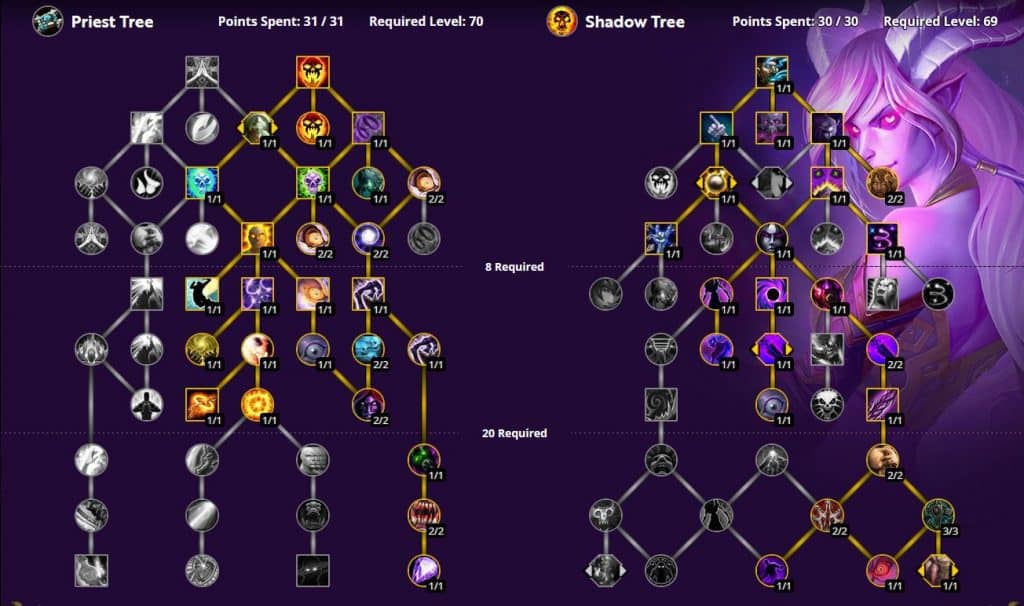WoW: Talent Trees in Dragonflight – So you can try them out now

The new talent trees are one of the great features of World of Warcraft: Dragonflight. We show you how you can already experiment with the feature.
With Dragonflight, Blizzard wants to return to the old strengths of World of Warcraft and strengthen the basic structure of the game a little. Therefore, there is a major revision, which mainly affects the talent system. Great talent trees are returning. We took a look at this feature and show you where you can already experiment with the already known talents.
This is how talents become in Dragonflight: Talent trees are making a return in the latest expansion. However, each class and specialization always gets 2 talent trees at the same time, for which different points are available:
- A talent tree for the class (priest, paladin, rogue, etc.)
- A talent tree for the specializations (Holy, Shadow, Discipline, etc.)
This means that you will get one talent point per level as you level up. Sometimes that’s one point for your class tree and sometimes one for your specialization tree.
How are the trees different? Basically, Blizzard takes different approaches with the two talent trees. The core idea is:
- Your specialization talent tree enhances what you do. As a DPS character, your damage increases and you get new attacks. As a healer, your healing becomes more efficient, you save mana or get new spells.
- Your class talent tree only increases the effects of your specialization in exceptional cases. Most of the talents here ensure that you have more variety or “utility” at your disposal. For example, you can reduce the mana costs of Dispells, unlock special movement effects or – in the case of healers – decide how strong you want to act as a hybrid. Now and then there are talents that simply make you better at what you already do.
This video shows what else Dragonflight has in store:
How are the talent trees structured? Anyone who has played other games with talent trees will quickly find their way around here. You start at the top of the talent tree and then work your way down point by point. Most talents are connected by lines. When you find a particular talent down there that you want that you want, you need to “make your way” to it and, if possible, select other talents that are appropriate.
Each talent tree is divided into three indirect “areas”. The top area is the base. This is where you’ll find many spells and abilities that are part of the standard toolkit of a specialization today. As a shadow priest you will find there “Mind Flay”, “Vampire Touch” or “Devouring Plague”.
In tiers 2 and 3 – as you slowly work your way down – the talents become more complex and have more interactions with your abilities. Often these are passive effects that refine your abilities and provide additional complexity. There are really big innovations in the last rows, in the end talents. Sometimes they have completely new effects.
Sometimes there is also a talent that gives you a choice, then you can choose between 2 options. For example, priests can choose to have Searing Nightmare or Misery when spending a talent point.
In order to get to the next area of the talent tree, 2 conditions must be met:
- You must choose a talent that has a connection to the next area of the talent tree.
- You must have spent at least 8 points in the 1st area to move to the 2nd area (to move from the 2nd to the 3rd area you must have spent 20 points).
Ultimately, you have 31 talent points to choose from for your class and 30 for your specialization. However, since there are significantly more than 30 talents to choose from, you will have to make a decision. Depending on the class, it is currently possible to unlock around 1-2 of the “final talents”.
This is how you can already test the talent trees: If you’re not lucky enough to be in Dragonflight’s alpha already, you can Talent Calculator from wowhead to use.
Note, however, that Blizzard is currently changing the talent trees frequently. What can be seen in the talent trees now could be outdated in a few days. A lot of feedback is currently being taken and many talents are still changing their position.
Talent tree example: The Shadow Priest in Dragonflight
To give you a better picture of the talent trees, let’s take a shadow priest as an example. It is expressly not optimized for maximum performance, but is only intended to show a possible path and clarify how the new talent trees are structured.

The image shows a fully populated talent tree – that is, at level 70. This gives you a rough idea of how many of the available talents are actually available and can be chosen. The tree in its current selection focuses on generating a large number of Shadowy Apparitions, which then grant bonus effects, such as creating a Shadow Servant that also casts spells.
Whether the talent trees can survive in the modern age remains to be seen. Many players fear that there will simply be “the one right way” again and that you will basically only take over successful talents from community sites without actually having a choice. So far, however, Blizzard seems to be trying to create as much variety as possible, so that there can be different playstyles within your own class and specialization.
How do you like the talent trees in Dragonflight so far?
If you want to brush up on your knowledge of WoW’s story, we’ve summarized all of World of Warcraft’s lore here.
Reference-mein-mmo.de